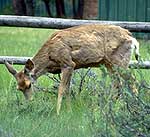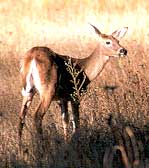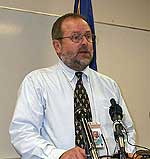By Mark Zdechlik
Minnesota Public Radio
August 16, 2002
The Minnesota Department of Natural Resources has unveiled plans to test thousands of hunter-harvested deer this fall for chronic wasting disease. Although the disease has not yet been found in any Minnesota deer, tests have found more than two dozen infected deer in Wisconsin. There is no evidence human can contract the disease from eating infected deer, however, scientists are looking into that possibility.
| |
|
|
|
||
In hopes of determining whether Minnesota deer are carrying chronic wasting disease - often referred to as CWD - the DNR has decided to dramatically expand its testing program.
The DNR's Wildlife Research Manager, Mike Doncarlos, says determining whether the disease has spread to Minnesota's deer population is his top priority. And toward that end, Doncarlos says the DNR will take tissue samples from 5,000 of the roughly 200,000 deer Minnesota hunters will take this fall.
The DNR will take the samples in 14 of Minnesota's 130 designated hunting permit areas. DonCarlos says the collection sites were carefully chosen.
"Trying to get a broad distribution geographically in the state, secondly - obviously with proximity to Wisconsin - we've concentrated in the southeast," Doncarlos says. "It would be extraordinarily difficult and impossible for us this year to design a sampling method that would address the entire state, so we're trying to get the best bang for our buck and directing the resources in key areas."
| |
|
|
|
||
This fall's testing will cost upwards of $400,000. The plan marks an ambitious departure from what the DNR had been doing. Over the past year, the agency tested less than 100 deer for CWD. Hunters approached by the DNR will have the option to allow the gathering of tissue samples. Doncarlos says he anticipates agency staff will have no problems getting what they need.
In fact, hunters organization have been pushing the DNR for increased testing. The Minnesota Deer Hunters Association, which claims 20,000 members out of the state's roughly 500,000 deer hunters, is welcoming the DNR's plans.
The organization's staff biologist, Corey Class, says hunters need to remember while CWD is a concern, it has not yet been found in Minnesota. Perhaps more importantly - there's no evidence humans can contract the disease by eating venison from infected deer.
"I think CWD needs to be put in perspective, which unfortunately hasn't been the case as of late. There are a lot of other diseases out there...like West Nile virus, rabies...that do and are known to go to human beings. ... They're not anywhere near the top of the chart for media right now," says Class.
| |
|
|
|
||
A federal health investigation is looking into possible connections between CWD and the 1990s brain disease deaths of a Blaine man and two Wisconsin hunting companions who often ate elk and deer. No connection to chronic wasting cisease has yet been discovered.
As states like Minnesota try to assess the threat of CWD, the Bush administration recently blocked nearly $18 million in funding that would have helped pay for CWD research and testing.
DFL U.S. Sen. Paul Wellstone is among those who've spoken out against the president's action. Wellstone says it's likely the funding will be restored eventually, but it's an emergency situation and the president should recognize that.
"One of the things that's been really maddening and frustrating to us in Minnesota is that the testing takes times as it is, and there has been all of this delay. So we were really hoping that this money would be coming to the state right away. We do view it as an emergency," Wellstone says.
Republican Norm Coleman, who's challenging Wellstone in this fall's Senate race, sent a letter to President Bush urging him to quickly restore the funding as well, citing among other things, the economic impact hunting has in rural Minnesota and Wisconsin.
Minnesotta's firearm deer hunting season begins in early November. The DNR says the testing will take between one and three months, and it will report to the public immediately the discovery of any positive samples.
More from MPRMore Information



